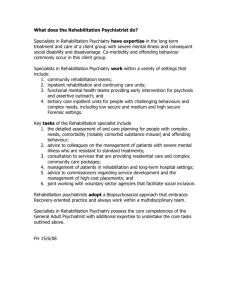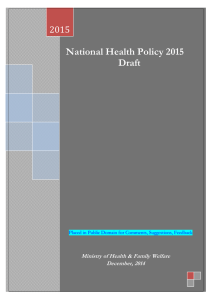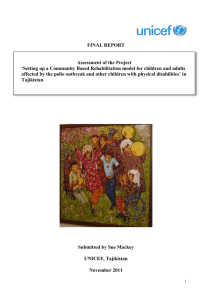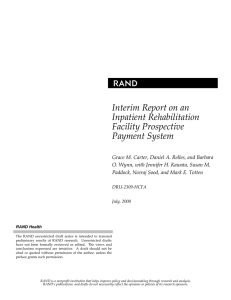Primary health care
advertisement
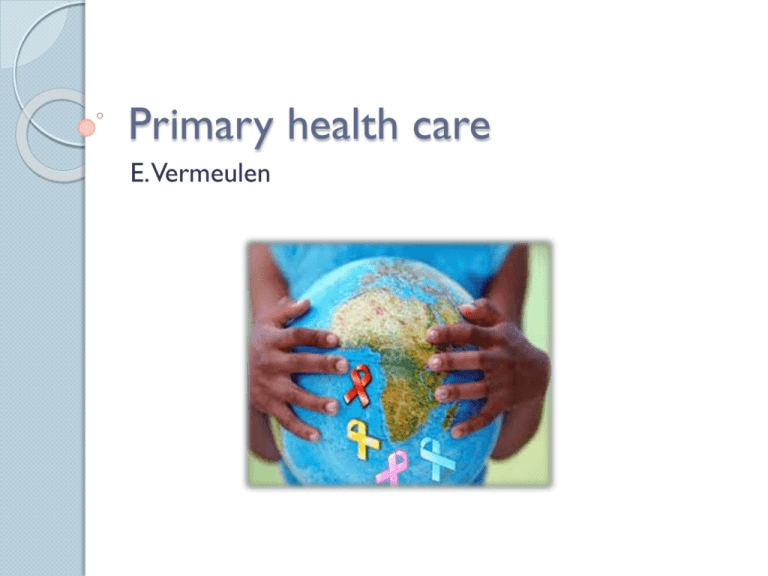
Primary health care E.Vermeulen Definition of primary health care. Primary Health Care as defined by the World Health Organization in 1978 is: Essential health care; based on practical, scientifically sound, and socially acceptable method and technology; universally accessible to all in the community through their full participation; at an affordable cost; and geared toward self-reliance and self determination. Eight essential components for PHC: 1.Education for the identification and prevention / control of prevailing health challenges 2. Proper food supplies and nutrition; adequate supply of safe water and basic sanitation 3. Maternal and child care, including family planning 4. Immunization against the major infectious diseases 5. Prevention and control of locally endemic diseases 6. Appropriate treatment of common diseases using appropriate technology 7. Promotion of mental, emotional and spiritual health 8. Provision of essential drugs (WHO & UNICEF, 1978). Basic conditions/terms for effective PHC Fair Acceptable Affordable Accessible Effective Definition of rehabilitation A goal-orientated and time limited process aimed at enabling an impaired person to reach an optimum mental, physical and/or social functional level, thus providing him/her with the tools to change his/her life. It can involve measures intended to compensate for a loss of function or a functional limitation and other measures intended to facilitate social adjustment or readjustment. Community Based Rehabilitation Community-based rehabilitation (CBR) focuses on enhancing the quality of life for people with disabilities and their families, meeting basic needs and ensuring inclusion and participation. CBR was initiated in the mid-1980s but has evolved to become a multi-sectoral strategy that empowers persons with disabilities to access and benefit from education, employment, health and social services. CBR is implemented through the combined efforts of people with disabilities, their families, organizations and communities, relevant government and non-government health, education, vocational, social and other services. (WHO) Levels of the National Health System First (entry) level - Clinics Clinics Manned by qualified primary healthcare nursing personnel, physiotherapists and/or other rehabilitation personnel. Second level – community health centres Community health centres manned by doctors, nursing personnel, pharmacists, physiotherapists and/or other rehabilitation personnel. Maternity services are usually available at these centers. Third level – District Hospitals District hospitals Manned by doctors, nursing personnel, dentists, social worker/s, dieticians, physiotherapists and/or other rehabilitation personnel. Emergency care is usually available here. Fourth level – Regional hospitals • The first step to more specialised service and long term patient care. Fifth level – Tertiary Hospitals Tertiary hospitals providing the most specialised medical services, such as heart-, brain-, abdominal-, pediatric-, obstetric- or spinal surgeries and the like. Care provided by physiotherapists at al levels of PHC Promotive care Preventative care Curative/therapeutic care Rehabilitative care Promotive care Promote health care at all levels Education programmes directed at achieving and maintaining healthy living, efficient function and optimal quality of life. Promotive care is also directed at the maintenance of optimal health in the already diseased or disabled. Examples...... Preventative care TYPES OF PREVENTION: Primary prevention: prevention of disease in a susceptible or potentially susceptible population through specific measures such as general health promotion efforts. Secondary prevention: efforts to decrease the duration of illness, severity of disease through early diagnosis and prompt intervention Preventative care cont’d Tertiary prevention: includes efforts to decrease the degree of disability and promote rehabilitation and restoration of function in patients with chronic and irreversible diseases Examples of each type of prevention? Curative/therapeutic care Assess and treat musculoskeletal, respiratory and neurological conditions. Examples.... Rehabilitative care Intervention measures taken to implement treatment, self management and educational programmes breaking the chain of impairment, disability or handicap. Restoration of optimal physical and functional independence.





